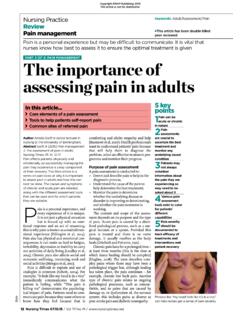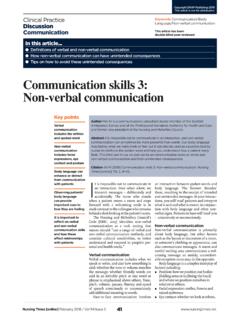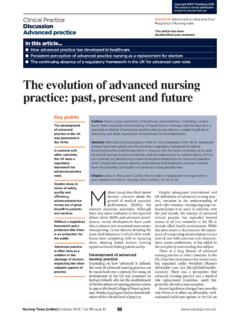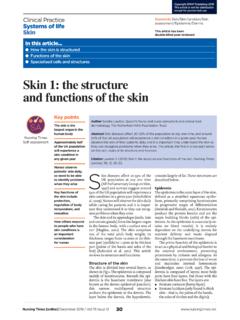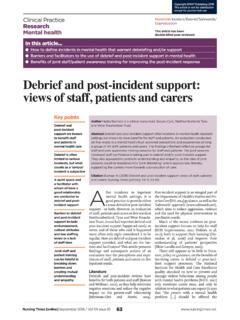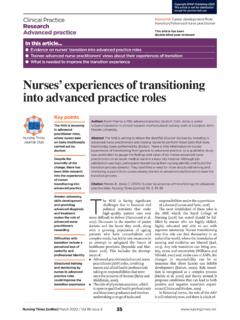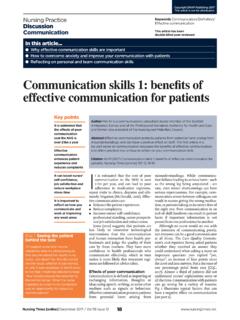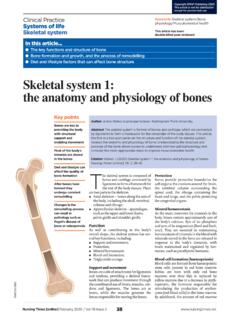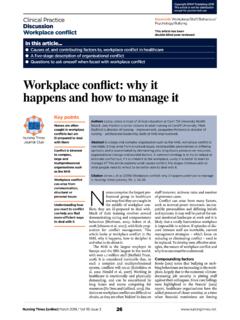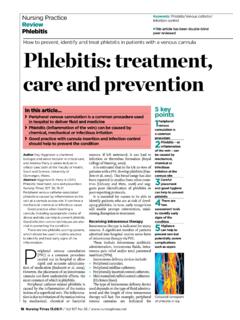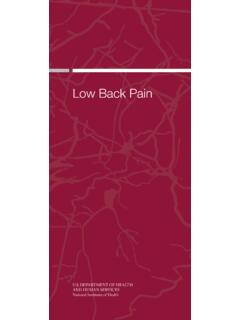Transcription of Understanding the effect of pain and how the human body ...
1 Copyright EMAP Publishing 2018. This article is not for distribution Clinical Practice Keywords Stimuli/Adaptive response/. pain signal/Nerve fibres/Mediators Review pain This article has been double-blind peer reviewed In this D. ifferent stages and mechanisms of pain transmission Physiological changes induced by pain Mediators that inhibit or promote pain Understanding the effect of pain and how the human body responds Key points Author Amelia Swift is senior lecturer in nursing, University of Birmingham. She has The body reacts to updated a 2003 article, Understanding the physiological effects of unrelieved pain , pain with a complex written by Carolyn Middleton, clinical nurse specialist at Gwent Healthcare Trust. adaptive response Abstract pain sends a signal that the body needs protection and healing. However, if pain is transmitted the physiological changes triggered by pain persist, harm will ensue, and acute pain from the site of may become chronic, so pain must be contained and/or relieved.
2 The mechanisms injury to the brain through which pain interacts with the body provide health professionals with various by electrical signals routes of entry and modes of intervention. This article discusses the intricacies of the adaptive response to pain and how they can be used to combat pain . Physiological changes triggered Citation Swift A (2018) Understanding pain and the human body's response to it. by pain are initially Nursing Times [online]; 114: 3, 22-26. useful but become P. harmful if they persist ain, which is caused by an Transduction unpleasant (noxious) stimulus, During transduction, the pain stimulus is Understanding pain is a stressor that can threaten transformed into a nerve impulse. Recep- physiology allows homoeostasis. The body's adap- tors on the surface of the nerve endings, health professionals tive response to pain involves physiolog- called nociceptors, respond to noxious to act on pain ical changes, which are useful and poten- stimuli, which can be thermal (tempera- mechanisms tially life-saving in the initial stages.)
3 If the ture above 40 C), mechanical (extreme adaptive response persists, harmful and pressure over a small area) or chemical Key nursing life-threatening effects may ensue. (strong acid or alkali). interventions to pain is noxious, which makes it a pow- The stimulus interacts with receptors, contain or relieve erful protective force: indeed the inability to causing chemical changes that lead the pain include holistic feel pain is associated with a shortened life nerve to create an electrical signal (action pain assessments expectancy (Shin et al, 2016). After injury, potential). The sensory nerve fibre will only pain encourages us to adopt behaviours create an action potential if the stimulus is that help the healing process; for example, strong enough. A large stimulus creates a resting the painful part of the body. higher frequency of action potentials, which This article describes the physiological is eventually perceived as more severe pain .
4 Response to pain , its clinical relevance and The stimulus causes the nerve and nearby its wide-ranging effects on the body. It also mast cells to release chemical pain media- explains how nurses can provide effective tors such as prostaglandin, bradykinin, ser- pain relief to their patients. otonin, substance P and histamine, which: l A ctivate more receptors on the nerve Transmission of pain fibre, increasing the likelihood that the The initial physiological changes taking threshold for an action potential will place in the body after a pain stimulus are be reached this is called primary concerned with the transmission of pain , sensitisation;. which involves four stages: transduction, l P rovoke changes in the walls of local transmission, perception and modulation. blood vessels, increasing blood supply Nursing Times [online] March 2018 / Vol 114 Issue 3 22 Copyright EMAP Publishing 2018. This article is not for distribution Clinical Practice Review and allowing white cells to move into Box 1.
5 Precautions with produced by the body; for example, the the extracellular fluid this is the NSAIDs and opioids opiate morphine, the antidepressant inflammatory response, an essential duloxetine or the anticonvulsant gabap- part of healing. Non-steroidal anti-inflammatory drugs entin. Descending pain inhibition can also pain can be alleviated by reducing the (NSAIDs) can lead to slower and poorer be stimulated by hypnosis (deep relaxa- sensitisation and activation of nerve end- bone and tendon healing (Su and tion), which has been used with good ings; for example, non-steroidal anti- O'Connor, 2013) and are linked to effect in acute and long-term pain , as well inflammatory drugs (NSAIDs) can inhibit gastric irritation and ulceration, renal as in patients with needle phobia the production of prostaglandin, one of the failure and increased risk of thrombosis (Brugnoli, 2016, Uman et al, 2013). The pro- main sensitising mediators, while opioids (Eccleston et al, 2017), particularly in duction of endogenous opioids can be can make it harder for the nerve to create an older people.
6 NSAIDs should only be stimulated by acupuncture, exercise and action potential. Precautions must be taken administered for short periods and after transcutaneous electrical nerve stimula- with both NSAIDs and opioids (Box 1). a careful assessment of the risks and tion (TENS) (Claydon et al, 2011). benefits (Zingler et al, 2016). pain can also be modulated by Transmission Opioids can cause sedation and ascending mechanisms. Activated by During transmission, the nerve impulse respiratory depression, especially in the touch or pressure, A-beta fibres trigger the travels from the site of transduction to the first 24 hours of use and when the dose same secondary neurons as C fibres. When brain in three stages: from nociceptors to is increased. The risk is increased in a C fibre activates the secondary neuron, spinal cord, from spinal cord to brain people with sleep apnoea or who had the signal created represents pain , but stem, and from brain stem to other parts of respiratory difficulties during surgery when an A beta fibre activates the sec- the brain.
7 (Weingarten et al, 2015). Morphine ondary neuron, the signal created repre- The electrical signal is conducted along should be given at the lowest effective sents touch. A beta fibres and C fibres com- the nerve by cycling of sodium and potas- dose and patients should be monitored pete to activate the secondary neuron, and sium ions between the extracellular and for signs of opioid-induced sedation, only one of them can win. If many A beta intracellular fluid. Transmission is which usually precedes respiratory fibres are activated, pain signalling is quickest along fibres that are myelinated: depression (Jarzyna et al, 2011). reduced; this is the principle of the gate A-delta fibres are lightly myelinated, so control theory (Melzack and Wall, 1965). they transmit pain signals more quickly In TENS, the sensation produced com- than C fibres. A-delta fibres transmit first defining and responding to pain . It takes petes with pain signals, which reduces the pain ' the sharp sensation felt immediately place in the cortex (location and motor onward signalling of pain from the dorsal after injury.)
8 C fibres transmit second pain ' response), the limbic system (emotional horn of the spinal cord (Sluka and Walsh, the duller, burning sensation that follows. response) and the reticular system (arousal 2003). This effect is like that obtained Once the signal reaches the end of the response). As part of a wider pain manage- when rubbing the painful area. long axon of the primary afferent fibre ment strategy, distraction can be an effec- When pain signals enter the dorsal horn (PAF), which stretches from the periphery tive technique to take the mind off pain ; it with high frequency, or with a low fre- to the spinal cord, it needs to cross a small has proven helpful in reducing the need for quency over a prolonged period, local fluid-filled gap the synapse. This is opioids in people with severe trauma pain changes further increase the pain signal. achieved by the release of neurotransmit- (Sullivan et al, 2016).
9 High-frequency inputs to the dorsal horn ters, which diffuse across the synapse and stimulate the release of not only the short- activate receptors on the next neuron in the Modulation acting transmitter glutamate, but also chain (secondary neuron), as well as on During modulation, the last stage of pain longer-acting transmitters substance P and nearby glial cells and interneurons. A strong transmission, pain is reduced or increased calcitonin gene-related peptide (CGRP). pain signal causes the release of enough by the body through descending (from These longer-acting transmitters stay on neurotransmitters to activate the secondary brain to spinal cord) and ascending (from the receptors of the secondary neuron for a neuron, and the signal then travels onwards spinal cord to brain) mechanisms. longer period, allowing summation to take to the brain, where it stimulates cells in the pain signals activate the brainstem, place (Woolf and Salter, 2000).
10 This is where brainstem, thalamus and cortex. which triggers descending nerve fibres to a pain signal is amplified as each change in The transmission of the pain signal can release endogenous opioids (endorphin electrical potential of the secondary neuron be stopped by applying a local anaesthetic and encephalin), serotonin, noradrena- is added to others to create a larger stimula- close to the nerve bundle, and it can be line, gamma-aminobutyric acid (GABA) tion. It leads to an enhanced responsiveness slowed down by administering an anticon- and neurotensin. These chemical media- of the secondary dorsal horn neuron, vulsant, such as gabapentin or pregabalin. tors activate receptors on the PAF and sec- known as central sensitisation. There is some evidence that these drugs ondary neuron to inhibit the release of At the same time nearby cells called glia help reduce neuropathic pain (Griebeler et neurotransmitters and make it more diffi- are stimulated to produce more mediators al, 2014), but there is a growing concern cult for the secondary neuron to create an that can sensitise and activate the sec- that some people can become addicted to action potential.
